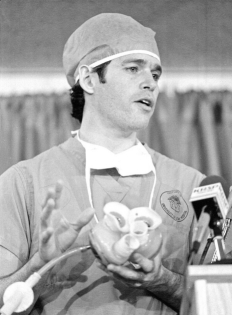Robert Jarvik facts for kids
Quick facts for kids
Robert Jarvik
|
|
|---|---|

Jarvik holding the Jarvik-7 artificial heart
|
|
| Born |
Robert Koffler Jarvik
May 11, 1946 Midland, Michigan, U.S.
|
| Died | May 26, 2025 (aged 79) New York City, U.S.
|
| Alma mater | |
| Occupation |
|
| Known for | Jarvik-7 artificial heart |
| Spouse(s) | |
| Children | 2 |
| Relatives | Murray Jarvik (paternal uncle) |
Robert Koffler Jarvik (born May 11, 1946, died May 26, 2025) was an American scientist and inventor. He is famous for helping to create the Jarvik-7 artificial heart, a special machine designed to replace a human heart.
Contents
Robert Jarvik's Early Life
Robert Jarvik was born on May 11, 1946, in Midland, Michigan. He grew up in Stamford, Connecticut. His brother, Jonathan Jarvik, became a professor of biological sciences. Robert's uncle, Murray Jarvik, was a scientist who helped invent the nicotine patch.
From a young age, Robert was very interested in how things work and in medicine. These interests later guided his career. By the time he was 17, he had already received five patents for his inventions.
Jarvik went to Syracuse University. He then earned a master's degree in medical engineering from New York University.
In 1971, he joined the University of Utah School of Medicine. There, he was hired by Willem Johan Kolff. Kolff was a doctor and inventor who had created the first dialysis machine. He was also working on other artificial organs, including a heart. Jarvik earned his medical degree (M.D.) from the University of Utah in 1976. He was a medical scientist, but he did not complete the training needed to practice medicine.
Developing the Artificial Heart
Jarvik joined the University of Utah's artificial organs program in 1971. His mentor, Willem Johan Kolff, led the program. At that time, they were using an artificial heart design that had kept an animal alive for ten days. Kolff asked Jarvik to design a new heart. This new design would solve problems with the older one. This work eventually led to the Jarvik-7 device.
In 1982, Jarvik's team performed an artificial heart implant. This was only the second time such a surgery had been done. The first was in 1969 by Domingo Liotta and Denton Cooley. On December 1, 1982, Dr. William DeVries implanted the Jarvik-7 into a retired dentist named Barney Clark. The surgery took place at the University of Utah.
Barney Clark lived for 112 days after the surgery. He needed frequent hospital visits. During this time, Jarvik and DeVries often spoke to the media. They updated the world on Clark's condition. The next few Jarvik-7 heart implants were done by a company called Humana. The second patient, William J. Schroeder, lived for 620 days with the artificial heart. In 1983, Jarvik and DeVries received the Golden Plate Award from the American Academy of Achievement.
In 2006, Jarvik appeared in TV commercials for a cholesterol medicine called Lipitor. Some members of Congress questioned if this was right. They wondered if his ads were like giving medical advice without a license. In one commercial, Jarvik was shown rowing, but a body double was used for that part. Later, Jarvik said he had not taken Lipitor himself until he became a spokesperson for the company. In February 2008, the company stopped using Jarvik in their advertisements.
Robert Jarvik's Personal Life
Robert Jarvik was married twice. He had a son and a daughter with his first wife, Elaine Jarvik. She was a writer and journalist.
On August 23, 1987, Jarvik married Parade magazine columnist Marilyn vos Savant.
Robert Jarvik passed away from Parkinson's disease at his home in Manhattan, New York, on May 26, 2025. He was 79 years old.
Images for kids
See also
 In Spanish: Robert Jarvik para niños
In Spanish: Robert Jarvik para niños


